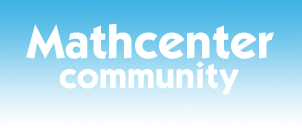
 |
|
|||||||
| สมัครสมาชิก | คู่มือการใช้ | รายชื่อสมาชิก | ปฏิทิน | ค้นหา | ข้อความวันนี้ | ทำเครื่องหมายอ่านทุกห้องแล้ว |
  |
|
|
เครื่องมือของหัวข้อ | ค้นหาในหัวข้อนี้ |
|
#1
|
||||
|
||||
|
สวัสดีครับ สมาชิก Mathcenter ทุกท่านครับ
ผมขอแนะนำตัวก่อนนะครับ ผมชื่อ หลวง เป็นติวเตอร์ ที่หมกมุ่นอยู่กับการพัฒนาหลักสูตรการสอนวิชาคณิตศาสตร์ แต่ต้องขอออกตัวก่อนว่า ผมไม่ได้เก่งวิชาคณิตศาสตร์ระดับเทพอะไรเลย ตอนนี้ผมศึกษาวิชาคณิตศาสตร์ ระดับปฐมศึกษา มาพอประมาณ และผมทำการวิจัย พฤติกรรมการเรียนรู้ของเด็กประถมครับ โดยเฉพาะ เด็กที่อ่อนวิชาเลข และเรียนเลขแล้วไม่ค่อยเข้าใจ ผมเจอจุดร่วมเดียวกัน และพบ ต้นตอปัญหาอย่างใหญ่ ในระบบการเรียนการสอนวิชาเลข เนื่องจากหลักสูตรการสอน วิชาคณิตศาสตร์ จะมุ่งเน้นการสอนให้ทำตามวิธีทำ แต่สิ่งที่ยังขาด คือ เด็กที่มีพัฒนาการ ที่ถนัดการใช้จินตนาการ หรือ เป็นเด็กที่ถนัดความคิดโดยใช้สมองซีกขวามากกว่า หรือใช้วิธีคิดอีกชุดหนึ่ง ซึ่งมันอาจจะยากเมื่อเป็น เป็นระบบ สัญลักษณ์ครับ ตรงนี้แหละ ที่ผมจะพัฒนา รูปแบบการสอน และเติมเต็ม หรือมาสนับสนุน ให้เด้กกลุ่มนี้ ได้ปรับตัว ให้มีพัฒนาการ การเชื่อมโยงทางความคิดระหว่าง สมองซีกขวาและสมองซีกซ้าย ให้ Balance กันมากยิ่งขึ้น ใน Internet ที่ผมเห็นรูปแบบการสอน เลข สำหรับเด็กอ่อน มีเทคนิคที่ผมดูแล้วค่อนข้างได้ผลลัพธ์ที่ดี อย่างเช่นอาจารย์ Rapcher ที่แกเน้นสอนไป แร๊ปเพลงไป อันนี้ถือว่าเป็นการกระตุ้น ให้เด็กจดจำแบบผ่านทางกิจกรรมที่สนุก แต่เข้าใจนะครับ ว่าหลายๆท่านอาจมองว่า ไร้สาระ หรือ ทำอะไรที่ดูเสียเวลา และอาจจะไม่ได้ performance ให้เด็กเก่งเทพๆได้ แต่ผมว่ามันมีคุณค่ามากสำหรับเด็กอีกกลุ่มหนึ่ง ที่ต้องการ ความคุ้นชิน หรือการปรับพฤติกรรมการเรียนรู้ ซึ่งผมมองว่า Rapcher ก็มีจุดดีของมันอยู่ แต่ของผมอาจไม่ได้ให้เด็กมาทำกิจกรรมร้องเพลง เล่นเต้นระบำอะไรแบบนั้น ซึ่งผมเองก็ไม่ถนัด ผมจะหาเป็นกิจกรรมที่เป็นการทำ workshop หรือให้เด็ก เห็นภาพจากงานประดิษฐ์ หรือนำเอา กระบวนการ เรียนทางวิทยาศาสตร์ ที่จับต้องได้ ที่มีอุปกรณ์ นำมาทดลองจริง แล้วเรียนคณิตศาสตร์ไปด้วย โดยเฉพาะเรื่อง ทศนิยม และเรื่องเศษส่วน ซึ่งสำหรับเด็กประถมที่ อ่อนคณิตศาสตร์นั้นมองว่า เป็นเรื่องที่ยากสำหรับเขา ที่ผมตั้งกระทู้นี้มา เพื่ออยากขอลองสอบถาม ขอ Feedback หรือคำแนะนำเพิ่มเติมจากสมาชิด Mathcenter ตรงนี้ครับ และอาจนำเสนอไอเดียอื่นๆ หรือ Resource จากแหล่ง internet ที่สามารถค้นคว้าเพิ่มเติม ผมว่า ประเด็นนี้ อาจไม่ได้เกี่ยวกับเรื่อง คณิตศาสตร์ 100% แต่ผมน่าจะเน้นไปถึงเรื่อง จิตวิทยา กับการพัฒนาการของ เด็ก ประมาณ 70% เลยหล่ะครับ ส่วน link URL นี้ เป็นหลักสูตรที่ผมกำลังร่างรายละเอียดลงใน website ของผมครับ https://redsiam.net/courses/mathemat...-weak-student/ รบกวนฝากความคิดเห็นกันด้วยครับ ขอบพระคุณมากครับ |
|
#2
|
||||
|
||||
|
Algebra Applied to Real life
Algebra is fundamental to many real-world activities, from personal finance and budgeting to science, technology, engineering, and sports. It helps us solve problems by setting up equations to find unknown values, manage money, calculate financial returns, and optimize systems. We use it to understand and analyze trends, design structures, create algorithms in computer science, and even in activities like cooking and gaming, often without realizing it. Science, Technology, Engineering, & Math (STEM) Engineering: Engineers rely on algebra to design structures, analyze forces, and ensure the safety of projects by applying mathematical formulas Computer Science: Software developers use algebraic concepts and algorithms to create programs and analyze data Health & Fitness: Calculating Body Mass Index (BMI) to monitor health or determine body fat percentage uses algebraic calculations Chemistry: Algebra helps in solving equations to determine chemical proportions and analyze reactions 20 อย่าง ในชีวิตประจำวันที่เราใช้ แอลจีบร้า https://differentbydesignlearning.co...everyday-life/ รวบรวมแหล่งเนื้อหา การถ่ายทอด เนื้อหาสาระ Algebra 04 กันยายน 2025 23:17 : ข้อความนี้ถูกแก้ไขแล้ว 1 ครั้ง, ครั้งล่าสุดโดยคุณ วัฒนาพรหมมาศ |
|
#3
|
||||
|
||||
|
Branches of Algebra
The complexity of algebra is simplified by the use of numerous algebraic expressions. Based on the use and the complexity of the expressions, algebra can be classified into various branches that are listed below: Pre-algebra Elementary Algebra Abstract Algebra Universal Algebra |
|
#4
|
||||
|
||||
|
Pre-algebra
The basic ways of presenting the unknown values as variables help to create mathematical expressions. It helps in transforming real-life problems into an algebraic expression in mathematics. Forming a mathematical expression of the given problem statement is part of pre-algebra. |
|
#5
|
||||
|
||||
|
Elementary Algebra
Elementary algebra deals with solving the algebraic expressions for a viable answer. In elementary algebra, simple variables like x, y, are represented in the form of an equation. Based on the degree of the variable, the equations are called linear equations, quadratic equations, polynomials. Linear equations are of the form, ax + b = c, ax + by + c = 0, ax + by + cz + d = 0. Elementary algebra based on the degree of the variables, branches out into quadratic equations and polynomials. A general form of representation of a quadratic equation is ax2 + bx + c = 0, and for a polynomial equation, it is axn + bxn-1+ cxn-2+ .....k = 0. |
|
#6
|
||||
|
||||
|
Abstract Algebra
Abstract algebra deals with the use of abstract concepts like groups, rings, vectors rather than simple mathematical number systems. Rings are a simple level of abstraction found by writing the addition and multiplication properties together. Group theory and ring theory are two important concepts of abstract algebra. Abstract algebra finds numerous applications in computer sciences, physics, astronomy, and uses vector spaces to represent quantities. |
|
#7
|
||||
|
||||
|
Universal Algebra
All the other mathematical forms involving trigonometry, calculus, coordinate geometry involving algebraic expressions can be accounted as universal algebra. Across these topics, universal algebra studies mathematical expressions and does not involve the study of models of algebra. All the other branches of algebra can be considered as the subset of universal algebra. Any of the real-life problems can be classified into one of the branches of mathematics and can be solved using abstract algebra. |
|
#8
|
||||
|
||||
|
แหล่งที่มา
https://www.cuemath.com/algebra/ |
|
#9
|
||||
|
||||
|
เรื่องเศษส่วน ทศนิยม ที่ผมเห็น ในแบบเรียนของ สสวท. ก็มีสอนเบื้องต้นโดยเน้นรูปภาพก่อนนะครับ ผมว่ามันก็น่าจะครอบคลุมเด็กส่วนใหญ่แล้ว ยังไม่เคยคนไหนที่ไม่เข้าใจเหมือนกัน อาจจะต้องเป็นเด็กพิเศษจริง ๆ
|
|
#10
|
||||
|
||||
|
อ้างอิง:
ปัญหาหลักๆคือ ผู้ปกครองไม่มีเวลา เข้ามาติดตามผลการเรียน เห็นว่าลูกทำการบ้านที่โรงเรียน แบบพอผ่านๆ หมายถึง สอบผ่าน คณิตศาสตร์ เกรด 2.5 ต้องบอกว่า เกรด 2.5 ในโรงเรียน Low Tier ถือเป็นเรื่องที่ น่าเป็นห่วงมากๆครับ พอผมลองเอา แบบฝึกหัด ป.1 มาให้น้องทำ น้องทำได้ แค่ 60% เท่านั้น (จากข้อสอบ 50 ข้อ) พอมาสอนตามการเรียนปัจจุบัน คือ ป.5 กลางเทอม 1 ย้อนไปทำเรื่อง เศษส่วน น้องไม่มีความสามารถในการ หานเท่า หรือเขียนในรูปเศษส่วน ที่บวกกัน ในรูปแบบ 1/2 ได้ ผมจึงต้องหากิจกรรม ที่จับต้องได้จริง แม้ว่า ลองเขียนเป็น ภาพ Pie หรือ การแบ่งพื้นฐานแล้ว น้องไม่สามารถเข้าใจได้ ผมต้องเอาผลไม้มาผ่าครึ่งให้เห็น เช่นเอามะนาว 7 ลูก มาผ่าออก ให้เห็นว่า 1/2 มันจัดเรียงอย่างไร แล้วลองทำการแบ่งกลุ่ม ให้เขาลองนับจริง พอทำแบบนี้ไปหลายๆรอบ ก็ลองใช้ดินน้ำมัน เพื่อการแบ่ง หลายๆ จำนวนเต็มให้เป็นเศษส่วน เพื่อไม่เปลืองผลไม้ด้วยครับ อันนี้ผมเห็นชัดเลยว่ามีเด็กในกลุ่มที่อยู่ในกลุ่มอ่อนเลขมากๆ มีจำนวนมาก เรียนเท่าไหร่ก็ไม่เข้าใจ หลักๆที่ทำได้คือท่องจำ ท่องว่าหาร จะทำอย่างไร ท่องว่าคูณจะทำอย่างไร พอเป็นแนว โจทย์ แก้ปัญหา ใช้ความคิด คือจบเห่ |
  |
| เครื่องมือของหัวข้อ | ค้นหาในหัวข้อนี้ |
|
|